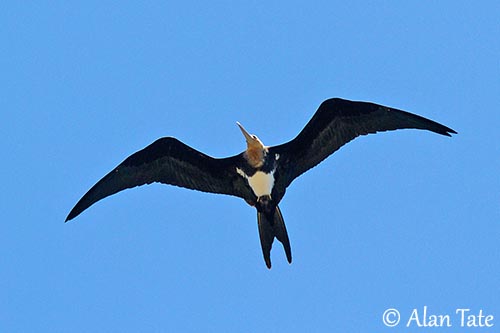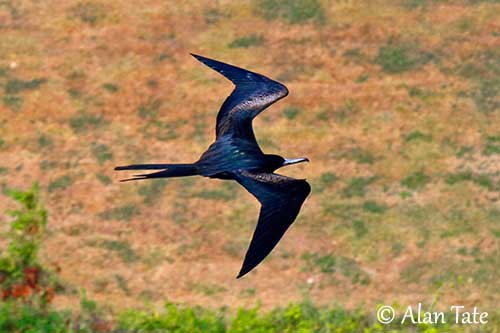
Fr: Frégate d’Andrews
Ang: Christmas (Island) Frigatebird - Christmas Frigatebird
All: Weißbauch-Fregattvogel
Esp: Rabihorcado de la Christmas
Ita Fregata di Andrews:
Nd: Witbuikfregatvogel
Sd: Christmasfregattfågel
Photographers:
Alan & Ann Tate
AA Bird Photography
Text by Nicole Bouglouan
Sources :
HANDBOOK OF THE BIRDS OF THE WORLD vol 1 by Josep del Hoyo-Andrew Elliot-Jordi Sargatal - Lynx Edicions - ISBN: 8487334105
BirdLife International (BirdLife International)
Australian Government – Department of the Environment
Animal Diversity Web (University of Michigan Museum of Zoology)
The Conversation - Australian endangered species: Christmas Island Frigatebird
By John Woinarski - Professor (conservation biology) at Charles Darwin University
Christmas Island - Seabird project
Red List of Threatened species
Page family Fregatidae
Summary cards
Christmas Frigatebird
Fregata andrewsi
Suliformes Order – Fregatidae Family
INTRODUCTION:
The Christmas Frigatebird has small breeding range on Christmas Island, in E Indian Ocean. This species is listed as Critically Endangered due to low breeding success and long breeding cycle, small and decreasing population, clearing of rainforest for phosphate mining, introduced Yellow crazy ants, cats and rats. These are the main threats which affect this bird.
Outside the breeding season, the Christmas Frigatebird disperses widely at sea, N to near the Philippines, and is exposed to hunting, entanglement in fishing nets and marine pollution.
This spectacular large seabird is well-adapted to this robust ecological role, but it may be so fragile in other traits. Like numerous island bird species, the Christmas Frigatebird is affected by human presence and its following consequences. Conservation strategies are needed.
DESCRIPTION OF THE BIRD:
Biometrics:
Length: 89-100 cm
Wingspan: 205-230 cm
Weight: M: 1400 g – F: 1550 g
The adult has black plumage, deeply forked tail and long, hooked bill.
The adult male has blackish-brown plumage overall, with green to bluish-green gloss on the blacker head, and on neck, mantle and scapulars. On the upperwing, there is a broad, pale brownish diagonal panel formed by paler secondary coverts. The forked tail is blackish.
On the underparts, we can see a conspicuous white patch on belly, but it does not reach vent or axillaries, although some males may show some few white feathers on outer axillary area.
The head is black with red gular pouch becoming inflated during the breeding season, but much duller and reduced outside breeding.
The long, hooked bill is bluish-grey. The eyes are dark brown, surrounded by narrow blackish eyering. Legs and feet are slaty grey.

The female is duller, with only little or no gloss on the upperparts. The white patch of belly is larger, extending from most of breast to rear belly, and to central axillary area. The collar on the neck sides contrasts with the black head. The bare parts including bill, gular pouch, eyering, legs and feet are pale pink.
The juvenile has whitish head, nape and upper breast, with strong orange to rusty tinge. It has dark brown upperparts with pale-edged feathers on mantle and scapulars, blacker flight feathers and broad, pale brown to whitish wing panel formed by the lesser secondary coverts.
On the underparts, breast sides and narrow pectoral band are dark brown. The white patch of belly extends to central flanks and to central axillaries. The bare parts including eyering, bill, legs and feet are pale bluish-grey to pale pink.
The young female becomes progressively whiter on the lower breast until reaching the adult plumage.
The young male has mostly blotchy neck and breast, and appears as intermediate between male and female.
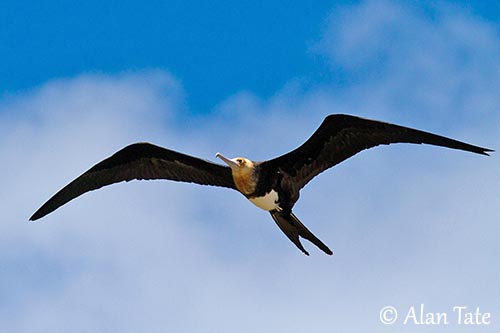
RANGE:
The Christmas Frigatebird breeds only on Christmas Island in E Indian Ocean, and forages in the surrounding waters. Outside the breeding season, it disperses widely throughout Southeast Asia and the Indian Ocean. This species is occasionally seen near Sumatra, Java, Bali, Borneo, the Andaman Islands and the Keeling islands.
HABITAT:
The Christmas Frigatebird spends most of its time at sea, coming to land for roosting and breeding. They often roost communally with other Fregatidae species, perching at least at 3 metres above the ground for easier landing and take-off.
This species breeds in the low, dry forest of the island, mostly in the outer part, in tall trees such as Indian Almond trees (Terminalia catappa) and Ficus.
CALLS AND SONGS: SOUNDS BY XENO-CANTO
The Christmas Frigatebird is vocal at breeding colonies. The displaying male is particularly noisy. The typical sounds produced by these birds are twittering, rattling, drumming (when the gular pouch is inflated) and whinnying. They also perform bill-clattering. The vibrating mandibles of a courting male against the inflated pouch used as a sound box, are very noisy. At nest, they give nasal, plaintive calls “kyeah… kyeah… kyeah”.
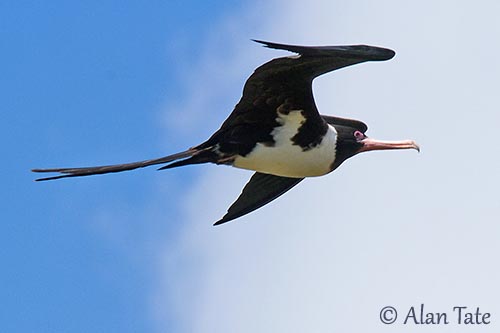
BEHAVIOUR IN THE WILD:
The Christmas Frigatebird is a surface feeder and forages in high temperature, low salinity waters, in the areas surrounding Christmas Island.
It feeds on flying fish, jellyfish, squid, large plankton and offal. It feeds by bill-dipping and occasionally immerses the entire head while flying low from water. It also takes eggs and chicks from seabirds and sometimes grasshoppers too.
Frigatebirds are known for using kleptoparasitism to obtain food from other seabirds. They harass them until they regurgitate their preys. The usual victims are the Red-footed Booby, the Abbott’s Booby, the Red-tailed Tropicbird, the White-tailed Tropicbird and the Brown Noddy around Christmas Island.
During the breeding season, several males can be seen displaying in tree canopy. The bright red gular pouch is fully inflated like a balloon. The wings are spread, the head is tipped back and the bird produces drumming noise with the bill vibrating against the pouch. These displays are used to attract the females flying above the male’s group.
The nest is usually built on the display site. They may nest in small colonies of 10, 20 to 30 pairs in the same tree. A new pair is formed every season, as the Christmas Frigatebird does not mate with the partner from the previous year.
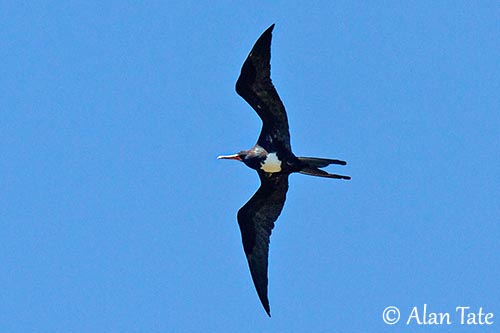
The Christmas Frigatebird breeds on Christmas Island, but it often forages hundreds of kilometres from the colony. Females and immatures perform post breeding dispersions N to S China Sea, and birds of all ages are reported near the Philippines. Vagrants have been reported in N Australia, Kenya and Hong Kong.
The Christmas Frigatebird is an excellent flier and can reach speeds of up to 50 km/h. It can spend days out at sea on the wing. It soars at great heights but does not perform sustained flapping flight, preferring soaring and gliding, or hanging in the air.
REPRODUCTION OF THIS SPECIES:
The pair is usually formed by end February, and the laying occurs mostly between March and May. The Christmas Frigatebird breeds in small colonies of 10, 20 to 30 pairs in the same tree, usually sheltered from high winds for easier landing.
The nests are placed under the top branches. It is a flimsy platform, built at 10-20 metres above the ground in tree fork, usually in Terminalia catappa and Celtis timorensis, occasionally Ficus.
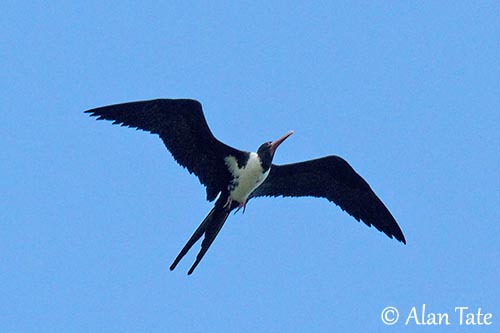
The female lays a single egg and both sexes incubate during 50-54 days. At hatching, the chick is naked, but it is quickly covered with white down. It is fed by regurgitation by its parents. It fledges 5-6 months after hatching, but the post breeding care may last 5-10 months and sometimes up to 15 months. It will be sexually mature at 5-7 years old.
The species is vulnerable to cyclones and forest fires as they breed colonially in a single tree.
PROTECTION / THREATS / STATUS:
The Christmas Frigatebird’s population declined following human settlement. In 2003, the population was estimated at 2,400/4,800 mature individuals, equating to 3,600/7,200 individuals in total. There were 1171 nesting pairs in 2003.
Habitat destruction and hunting, but also weather conditions and the introduced Yellow crazy ants (Anoplolepis gracilipes) have a serious impact on the ecosystem.
The Christmas Frigatebird is currently considered as critically Endangered, with a population still decreasing.
